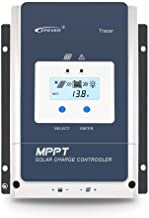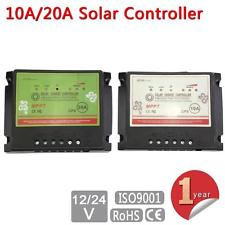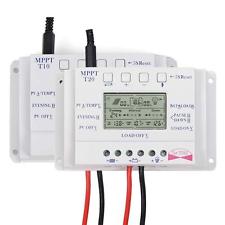This is an old revision of the document!
Table of Contents
Chinese MPPT charge controllers
Prior to the introduction of Chinese controllers, MPPT was an expensive feature found only on controllers costing hundreds of dollars. Chinese controllers cost about half the price of premium controllers.
PWM controllers have their own page.
Tracer
Current production models are below; older models have been moved.
nomenclature
Many of the Tracer series follow a model number pattern consisting of rated current, max voltage input, and “ground”.
Example: EpEver 2206AN =
quirks
Some voltage setpoints are constrained in relationship to each other. Because of this it may be easiest to configure them in a particular order.3) This order places the configurations in increasing (or equal) voltages the way the controller wants it.
- “Low Voltage Reconnect Voltage”
- “Boost Reconnect”
- Then “Float Charge”
- Then “Boost Charge”
- Then “Equalize Charge”
- Then “Over Voltage Reconnect”
- Then “Charging Limit”
- Then “Over Voltage Disconnect”
 Tracer (and the Renogy rebrands) refer to the Absorption stage as “boost”. This is an unforced error; the nonstandard term confuses newcomers and conflicts with the already-existing “MPPT boost” term.
The battery icon found on many Tracer controllers is unnecessary and misleading. The manual claims it is a State of Charge meter but there is no guide to reading it. Since the same voltage can result in different display during charging and non-charging scenarios, it may actually be useful to think of as a charging indicator rather than state of charge indicator. Secessus' unscientific observation reveals these weak correlations:
Tracer (and the Renogy rebrands) refer to the Absorption stage as “boost”. This is an unforced error; the nonstandard term confuses newcomers and conflicts with the already-existing “MPPT boost” term.
The battery icon found on many Tracer controllers is unnecessary and misleading. The manual claims it is a State of Charge meter but there is no guide to reading it. Since the same voltage can result in different display during charging and non-charging scenarios, it may actually be useful to think of as a charging indicator rather than state of charge indicator. Secessus' unscientific observation reveals these weak correlations:
| Charging | Not charging | |
| 5 bars / 100% | Float | |
| 4 bars / 80% | late Absorption | |
| 3 bars / 60% | early Absorption | ⇐ Vfloat |
| 2 bars / 40% | late Bulk, >=Vfloat | |
| 1 bar / 20%: early bulk | early Bulk, <Vfloat | ⇐ Vreconnect |
| 0 bar / 0%: | not charging | ⇐ Vlvd |
The LOAD icon (light bulb ON/OFF) indicates whether the LOAD terminals are powered, not whether or not anything is connected to them or consuming power.
A series
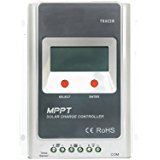 The A series has a front LCD display and rear-facing heat fins. It can handle up to 100v of solar input.
The A series (and BN below) use the MT-50 display. Communications are via RJ-485 adapter and the LS-B protocol (pdf). Open source software is available.
The A series has a front LCD display and rear-facing heat fins. It can handle up to 100v of solar input.
The A series (and BN below) use the MT-50 display. Communications are via RJ-485 adapter and the LS-B protocol (pdf). Open source software is available.
AN series up to 40A
The AN variant is “negative ground” but is otherwise indistinguishable from the A series.
AN series 50A and higher
The >=50A AN series uses the same display and possibly firmware of the smaller AN units, but has several differences:
- very large and heavy; make sure you have space before ordering one
- 100v, 150v, and 200v versions is instead of 60v/100v in smaller AN
- removable cover over wiring terminals
- battery voltage sensing wire can be plugged into a small terminal plug
- LOAD output is removed; low LOAD functionality remains via small terminal plug1,used only for relays and controlling generators
Variants:
- 5415AN - 50A, 12/24/48v banks, 150v input
- 5420AN - 50A, 12/24/48v banks, 200v input
- 6210AN - 60A, 12v/24v banks, 100v input
- 6415AN - 60A, 12/24/48v banks, 150v input
- 6420AN - 60A, 12v/24v/48v banks, 200v input
- 8415AN - 80A, 12/24/48v banks, 150v input
- 8420AN - 80A, 12/24/48v banks, 200v input
- 10415AN - 100A, 12/24/48v banks, 150v input
- 10420AN - 100A, 12/24/48v banks, 200v input
When assessing input voltage needs, see the manuals that specify how ambient temperature affects Vmax tolerance.
BN series
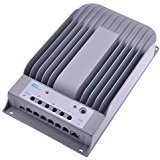 The BN series has no display. It has massive front-mounted heat fins. It is the first Tracer with so-called negative ground.
The BN controllers use the same comms setup as the A series above. Some users have reported sluggish PPT under changing conditions.
The BN series has no display. It has massive front-mounted heat fins. It is the first Tracer with so-called negative ground.
The BN controllers use the same comms setup as the A series above. Some users have reported sluggish PPT under changing conditions.
eTracer BND series
This 150v, “negative ground” controller looks like a BN with an inset display module. Comms are by RS232, CAN BUS and Ethernet. The eTracer is also sold as the Renogy Commander. manual (pdf)
Triron series
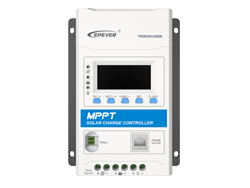 The Triron is also sold as the Renogy Rover, which can be programmed using the free software.
The Triron is also sold as the Renogy Rover, which can be programmed using the free software.
SPP programmers
The SPP-01 and -02 appear to be devices that can be used to backup or configure Tracers in the field. They are largely undocumented.
MT-50 display
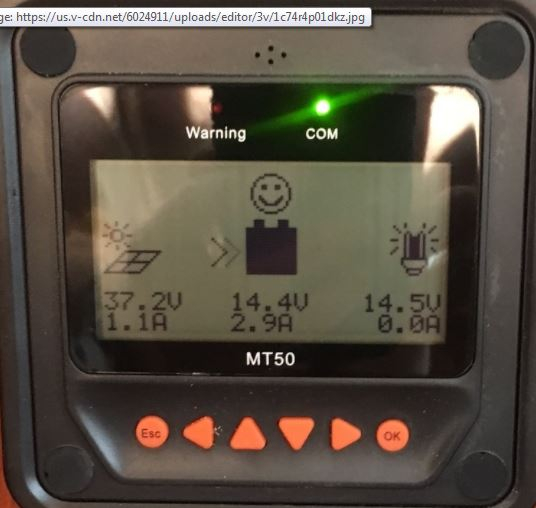 The MT-50 display is not a meter per se. It is a display for controller information and an interface by which configuration changes can be made.
The default screen shows input from panel (volts and amps), output to battery (volts and amps), and output to LOAD (volts and amps).
The LOAD icon (light bulb) has rays around it when the load circuit is on; this does not mean there is a load present.
The MT-50 display is not a meter per se. It is a display for controller information and an interface by which configuration changes can be made.
The default screen shows input from panel (volts and amps), output to battery (volts and amps), and output to LOAD (volts and amps).
The LOAD icon (light bulb) has rays around it when the load circuit is on; this does not mean there is a load present.
Because of a tweak Renogy made to their version of the controllers, the plain MT-50 will not work and you must pay extra for the Renogy MT-50.
MT-75 display
A MT-75 display is available in some regions. It has two RJ-45 inputs for connection to both the charge controller and an inverter
- manual (pdf)
- YT overview by Adam Welch
wireless modules
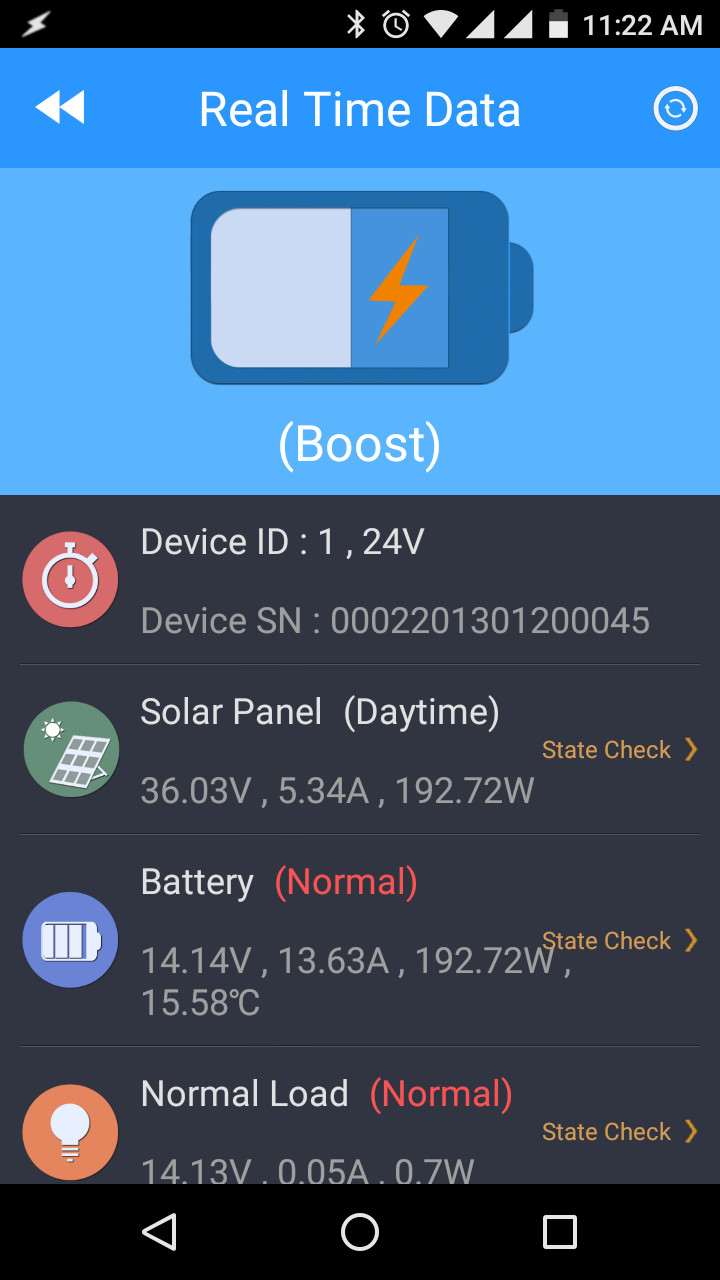 Epever makes bluetooth and wifi modules that plug in to the same port the MT-50 uses. This allows the free smartphone app to connect to the controller over bt/wifi for configuration and display. Pic to the right is from secessus' rig.
Renogy rebadges the modules for their [rebadged] controllers.
Epever makes bluetooth and wifi modules that plug in to the same port the MT-50 uses. This allows the free smartphone app to connect to the controller over bt/wifi for configuration and display. Pic to the right is from secessus' rig.
Renogy rebadges the modules for their [rebadged] controllers.
Note that these apps talk directly to the modules over BT/Wifi; they do not pair to the phone or connect to the wifi access point. Connect to the module through the app itself.
Eco-worthy
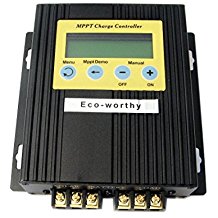 The Eco-worth was one of the first low-priced true MPPT controllers on the market.
Eco-worthy refers to three stage charging as “impulse, bulk, and float”.
Youtube review: eBay MPPT Solar Charge Controller Review - 12v Solar Shed.
The Eco-worth was one of the first low-priced true MPPT controllers on the market.
Eco-worthy refers to three stage charging as “impulse, bulk, and float”.
Youtube review: eBay MPPT Solar Charge Controller Review - 12v Solar Shed.
MPPT boosting controllers
 The mpt-7210a 10A controllers are indeed MPPT, but of limited use for RVers. They are strictly “boosting” (upconverting) controllers instead of the usual downconverting controllers. This means they could be used to charge a 24v bank from 12v panels. Or, for example, a 48v ebike from 12v portable panels.
[This company needs to make a normal MPPT at this price point! – secessus]
The mpt-7210a 10A controllers are indeed MPPT, but of limited use for RVers. They are strictly “boosting” (upconverting) controllers instead of the usual downconverting controllers. This means they could be used to charge a 24v bank from 12v panels. Or, for example, a 48v ebike from 12v portable panels.
[This company needs to make a normal MPPT at this price point! – secessus]
fake MPPT units
The following units are “fake” in the sense that they do not do MPPT. Some are PWM, some are shunt. This doesn't mean they won't work but it does mean they are marketed incorrectly. Adjust your willingness to pay based on actual function.
CPT/CPY
CPT-LA10
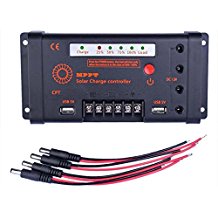 The CPT is a non-adjustable 10A controller with claimed 100v input.
Adam Welch tested to 40+ voltage. Vabs appeared to be 14.7v and Vfloat appeared to be 13.5v, although it could be a charge-and-stop unit that happened to rest at 13.5v.
CPT manual
Youtube review: Another Cheap MPPT Charge Controller - CPT-LA10 - 12v Solar Shed
The CPT is a non-adjustable 10A controller with claimed 100v input.
Adam Welch tested to 40+ voltage. Vabs appeared to be 14.7v and Vfloat appeared to be 13.5v, although it could be a charge-and-stop unit that happened to rest at 13.5v.
CPT manual
Youtube review: Another Cheap MPPT Charge Controller - CPT-LA10 - 12v Solar Shed
CPY-2410
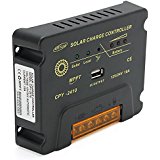 Note: while early versions (1.6) were reported to do actual MPPT, later versions (2.3) are reported to be dumbed down. The later versions still do DC-DC conversion but do not track powerpoints; they run the panels about 2v higher than battery voltage. See the comments on this test video and these blog posts.
Youtube review: UEIUA Cheap MPPT Solar Charge Controller - 12v Solar Shed
Note: while early versions (1.6) were reported to do actual MPPT, later versions (2.3) are reported to be dumbed down. The later versions still do DC-DC conversion but do not track powerpoints; they run the panels about 2v higher than battery voltage. See the comments on this test video and these blog posts.
Youtube review: UEIUA Cheap MPPT Solar Charge Controller - 12v Solar Shed
CPS-2410
M10 / T10
CMT
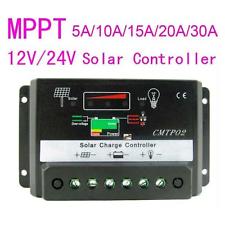 CMT controllers are non-adjustable PWM of decent quality, sometimes sold by unscrupulous or uninformed sellers as MPPT.
CMT controllers are non-adjustable PWM of decent quality, sometimes sold by unscrupulous or uninformed sellers as MPPT.
waterproof
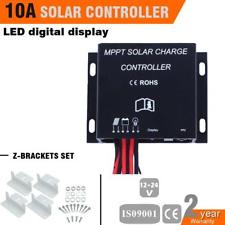 The waterproof controllers are pwm at best. Confirmed by Adam Welch.
The waterproof controllers are pwm at best. Confirmed by Adam Welch.

